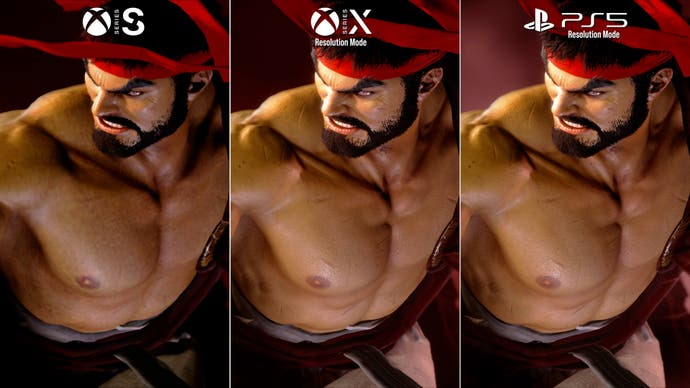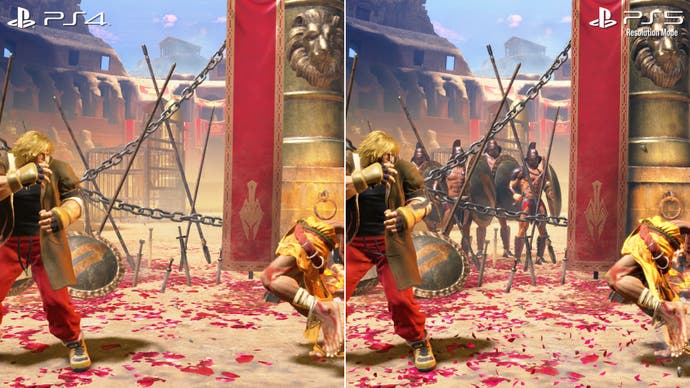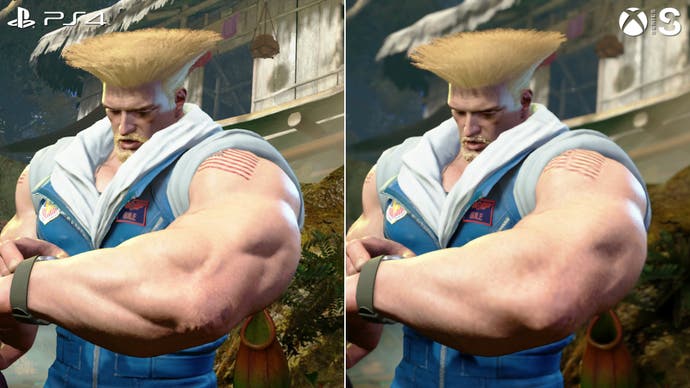Street Fighter 6: a generational divide between PS4 and PS5/Series X - with Series S in the middle
Plus: the best options to reduce input lag for the best response.
Street Fighter 6 is a gargantuan project for Capcom. It's a game in three parts, between the World Tour adventure, the Battle Hub online lobbies and the classic Fighting Ground 1v1 battling - and it all combines to create a truly feature-complete game at launch. So how does the game look and run? What separates PS5 and Series X from the Series S experience and how do the PS4 and Pro versions slot in? And crucially, what about input lag - the time taken between button press and response? This is crucial for a fighting game and the good news is Capcom has innovative solutions here to reduce latency.
Starting at the top, both PS5 and Series X run with a 3840x2160 target - a full 4K resolution - at 60 frames per second, and both deliver all the bells and whistles. They're a feature match. We get crisp textures, screen-space reflections in every mode, along with Capcom's muscle deformation tech as characters deliver their finishing moves. Both also run at a fluid 60 frames per second in the arcade mode, with no problems for the classic 1v1 action.
However, the World Tour mode doesn't run well on its default settings on PS5 or Series X. This free-roaming adventure is a kind of Yakuza-lite as you take on missions, and challenge opponents on the street. However, engaging in 1v1 battles triggers a 30fps cap. It's an unevenly frame-paced 30fps, and feels unresponsive to control as a result. The fix is simple: go to the options menu and switch over to the performance mode instead. This mode change only allows the World Tour battles to run at 60fps by forcing the resolution down to 1440p rather than 4K for the rest of the package. And just to stress, the regular Fighting Ground mode - the traditional 1v1 battle - still runs at 4K and 60fps even with performance mode selected.
Next along is Xbox Series S. Series S users will be glad to hear the game does run well at 60fps, even if the visual cutbacks to get there run surprisingly deep. For a start, whether it's the arcade mode or the World Tour mode adventuring, the game renders at a native 1920x1080. Impressively, the full HD resolution gets us to 60fps in the World Tour mode, even during 1v1 battles on the street. There is no resolution or performance mode toggle on Series S, but at least Capcom gives us a 60fps-optimised way to play out of the box anyway... mostly, at least.
Expect more drops and hitches below 60fps as you sprint through the open environments on Series S. For the most part though, it's solid based on my time around the Chinatown and central Metro City areas. Crucially, the arcade mode portion of the package is a watertight 60fps too. You're at no competitive disadvantage on Series S in terms of its mechanics, even if image quality and visual features are stripped back compared to PS5 and Series X.
In addition to the reduced resolution, Series S has other cutbacks: easily the most distracting issue is the textures and the presentation of fine detail like hair. Series S has the distinction of having the worst quality textures of any console release, including even PS4 and PS4 Pro. Materials on characters - the skin, clothing - all render with low resolution assets. It's not simply the drop to 1080p causing it either; it's the content itself, especially viewing all these characters up close. Pair that with the heavy dithering artefacts on hair and it's a disappointing turnout. Muscle deformation on the characters is removed, too, while background details and some shadows are also cut.


While Capcom has vetoed a last-gen Xbox One console release of the game, both PS4 and PS4 Pro are supported and run excellently too, as long as you only care about the classic arcade mode. Any traditional 1v1 gameplay in the Fighting Ground segment is a pure 60fps, with zero compromise on performance, just as it should be. There's online cross-play with Series X, PS5 and PC and both PS4 and PS4 Pro are more than up to holding their own here. Sure, there are visual cutbacks, starting with a drop to a native 1080p on base PS4. However, PS4 Pro guns for a more ambitious 1440p - higher than even Series S - while still maintaining 60fps.
The catch to all of this is a compromised World Tour mode, with a highly variable frame-rate. On base PS4 for example, it's an unlocked, wavering 40-60fps while exploring the Metro City area. And then in battle, you're forced into a capped 30fps experience with no way to toggle out of it. The way World Tour mode runs is easily the biggest drawback to playing on last-gen. Even PS4 Pro has issues and again we have an unlocked 40-60fps, with battles capping to 30fps. My issues with World Tour mode in the demo carry over to the final game: the low quality textures, NPC pop-in, half-refresh NPCs at range and the low quality screen-space reflections remain on all systems. Worse still, there's also a texture bug on the last-gen versions, with ground textures popping back to a lower grade asset after cutscenes.
How do the last-gen consoles compare to Series S? We’ve already seen that remarkably the PS4 generation machines use higher quality textures than Series S. However, there are more cuts on the older hardware in general. Firstly, screen-space reflections are removed from water in the arcade mode battles on PS4, while ambient occlusion is dialled back. That said, SSR is still engaged on PS4 Pro on a low preset, running at the same quality as Series S. Secondly, physics-based elements like the cherry blossoms on the Genbu stage are now static elements on PS4 and Pro, unlike Series S. There's zero movement on the ground making it a current-gen extra. There are many other small changes in shadows and texture filtering, meanwhile - but the dropped SSR and physics are the standout points.


Perhaps one of the biggest questions we've had about Street Fighter 6 - or any 2D fighter in our coverage - relates to its input latency. That is, the time it takes between your controller or stick registering an input, and then seeing an on-screen response. Just how fast, how responsive is the RE Engine? Thanks to latency testing expert Nigel Woodall, it's been possible to put some raw numbers against each console. The good news being? In the absolute best case, the PS5, Xbox Series X, Series S and PC all run at between 57-58ms latency. The decimal variances between these results fall wihin the margin of error, and fundamentally all deliver comparable returns. Meanwhile Series S achieves a slightly more rapid 55.6ms - though again, the lead is by a small margin overall.
For competitive Street Fighter 6 players this is fantastic news. For reference, the 57.4ms reading on PS5 compares very favourably to previous Street Fighter games as well, when played on PS5 hardware. For example, Ultra Street Fighter 4 gives an input latency result of 67.6ms, while Street Fighter 5 comes in at 79.9ms. Each of these older games run as PS4 apps on the very same PS5 hardware as we're testin treet Fighter 6 - and the result is clear-cut. Street Fighter 6 when set up correctly is the most responsive in the series' recent history.
| Input Latency (ms) | PlayStation 5 | Xbox Series X | Xbox Series S | PC |
|---|---|---|---|---|
| IDR Enabled + VRR Enabled | 57.4 | 58.3 | 55.6 | 58.1 |
There is a condition to achieving these rapid, low latency results on console. Out of the box - and taking PS5 as an example in isolation - Street Fighter 6 actually runs at 99.3ms on its default settings. The key to boosting this number? That'll be the Input Delay Reduction mode found in its settings menu. Enabling the IDR mode allows PS5 - and Series X and S - to output at 120Hz and further reduce latency to 62.3ms. This is at times coupled with tearing, though curiously the tearing disappeared on several playthroughs after a restart. And better still, those with a Variable Refresh Rate display (VRR), are able to reduce this even further by enabling FreeSync. With both IDR mode and VRR combined, this shaves off 42ms overall compared to the default setting - a difference of between 2-3 frames.
A few final points on this latency business. Again Nigel Woodall deserves full credit for his work here, and his diligence in keeping tests consistent across all consoles. In this case, all tests run using a wired arcade stick equipped with a Brook UFB board - allowing for a low latency input. A DualSense or Xbox Series X controller running wirelessly will add to the milliseconds over our recorded results, but not substantially for most players. Again, the latency points here will mainly be of interest to the most competitive players where every millisecond, every frame, counts.
Equally, Nigel's testing proves there is no difference between the game's resolution and performance modes, while playing in the Arcade mode at least. This graphics toggle only affects the Word Tour mode - where of course boosting the frame-rate from 30fps to 60fps in battles makes a huge difference to responsiveness in itself. Likewise, outputting the console at a different resolution - at 1080p or 4K makes no odds - and the results don't improve either way.
| Input Latency (ms) | IDR Disabled | IDR Enabled | IDR + VRR Enabled |
|---|---|---|---|
| PlayStation 5 | 99.3 | 62.3 | 57.4 |
Overall then, Street Fighter 6 is a remarkably complete package at launch. It addresses a significant problem with SF5 at its own release, way back in 2016, where key features went missing. It’s also good to see that input latency is a real consideration for the team this time. We get the tools to adjust the game - with the IDR mode - letting us whittle the milliseconds down between input and on-screen response. For competitive players on PS5, Series X and S - and PC - no-one is left behind, and all run with great results in the best-case. But be warned it does take the right hardware to get there.
If there's unfinished business with Street Fighter 6 right now, it relates to the less powerful machines: PS4 and PS4 Pro owners will certainly feel the drop to 30fps in its World Tour mode battling, while the cuts to the Series S build - particularly in terms of texture quality that looks worse than base PS4 - feel extreme and I'd hope to see Capcom improve this build. That aside though, the arcade mode action - the traditional 1v1 gameplay - is simply superb and a locked 60fps line regardless of your platform. And honestly for that alone it puts the Street Fighter series in a very good place.









